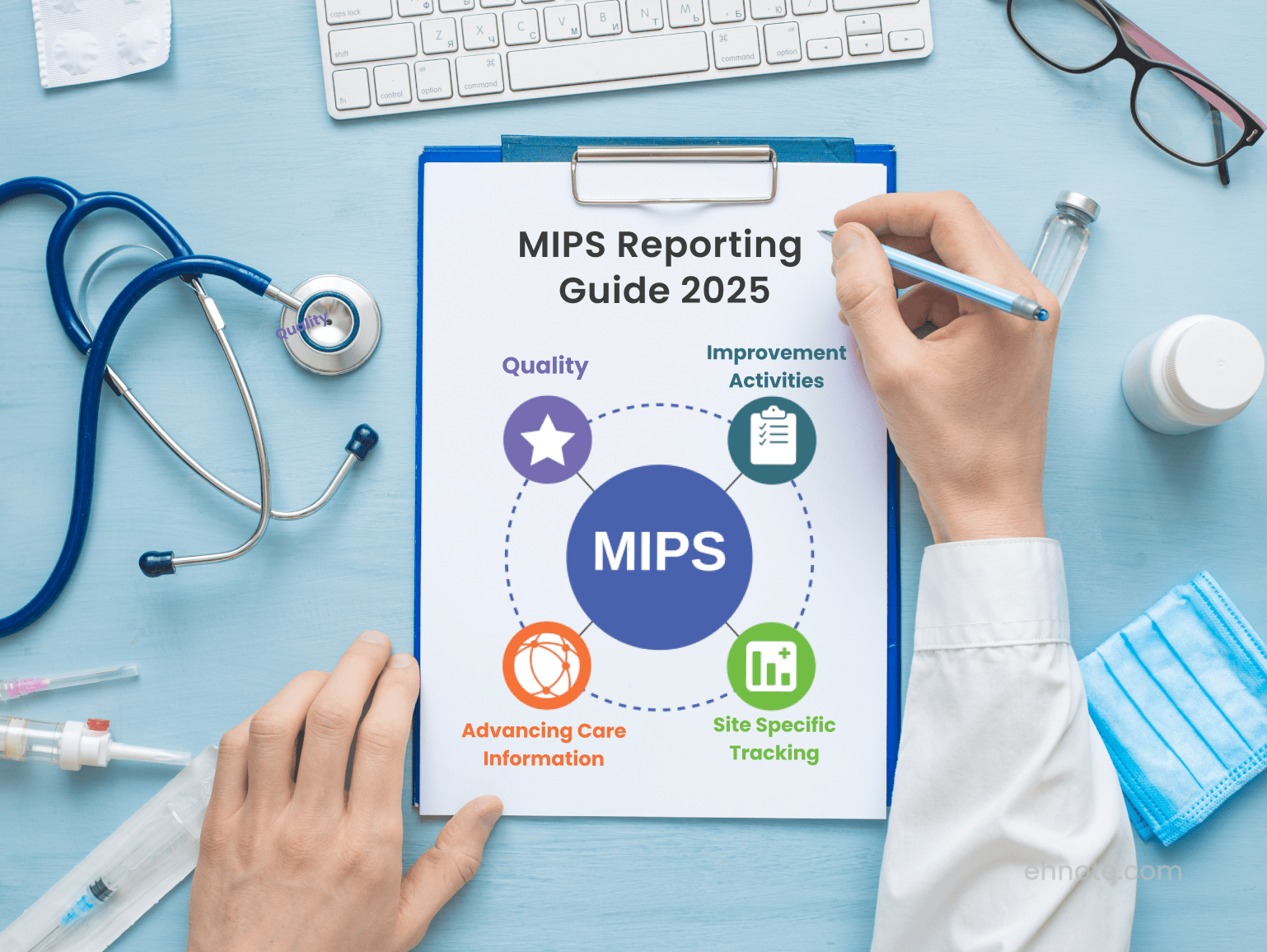Step-by-Step Guide to MIPS Reporting for Ophthalmologists in 2025

As an ophthalmologist, you’re dedicated to preserving vision, but in 2025, navigating the Merit-Based Incentive Payment System (MIPS) is just as critical to preserving your practice’s financial health. MIPS, part of CMS’s Quality Payment Program, rewards or penalizes clinicians based on performance in quality, cost, improvement activities, and interoperability.
For eye care specialists, getting MIPS right can mean a positive payment adjustment of up to 9%—or a penalty of up to 9% if you fall short.
Let’s break down the process into clear, actionable steps to ensure your success in MIPS reporting for 2025, helping you avoid penalties, maximize scores, and focus on what matters: your patients.
Step 1: Confirm Your Eligibility and Participation Status
First, determine if you’re required to participate in MIPS for 2025. As an ophthalmologist, you’re likely eligible if you’re a Medicare Part B clinician (e.g., MD, DO, or OD) and meet the low-volume threshold criteria: billing more than $90,000 in Medicare Part B charges, seeing over 200 Medicare patients, and providing over 200 covered professional services annually.
CMS updates these thresholds yearly, so check your status via the QPP Participation Status Tool on qpp.cms.gov using your National Provider Identifier (NPI).
If you’re part of a small practice, you may qualify for special considerations, like hardship exemptions for Promoting Interoperability. You can participate as an individual, group, or virtual group, but for ophthalmology practices with multiple locations, group reporting often simplifies the process.
Step 2: Understand the 2025 MIPS Categories and Scoring
MIPS performance in 2025 is based on four categories, each contributing to your final score (out of 100 points). The threshold to avoid a penalty is 75 points, but scoring higher can earn you a positive adjustment. Here’s the breakdown:
- Quality (30%): Report on six measures relevant to ophthalmology for a full year (January 1–December 31, 2025). Examples include Measure 14 (Age-Related Macular Degeneration: Dilated Macular Examination) or Measure 19 (Diabetic Retinopathy: Communication with the Physician Managing Ongoing Diabetes Care).
- Cost (30%): CMS calculates this based on your Medicare claims data—no submission required. For ophthalmologists, costs are often tied to procedures like cataract surgery.
- Improvement Activities (15%): Complete activities that enhance care, like implementing telehealth for follow-ups. You need 40 points (e.g., two high-weighted activities at 20 points each).
- Promoting Interoperability (25%): Report on measures like e-prescribing and patient portal access for 180 consecutive days. Small practices can apply for exemptions if technology constraints exist.
Understanding these categories helps you prioritize efforts. For ophthalmologists, Quality and Promoting Interoperability are key areas to control, as Cost is calculated automatically, and Improvement Activities are often straightforward.
Step 3: Select Ophthalmology-Relevant Quality Measures
Choosing the right Quality measures is critical for a high score. CMS offers over 200 measures, but as an ophthalmologist, focus on those specific to eye care. Here are some recommended measures for 2025:
- Measure 14: Ensure dilated macular exams for AMD patients—report on at least 90% of eligible patients.
- Measure 19: Document communication with primary care for diabetic retinopathy patients, a high-priority measure.
- Measure 117: Report on dilated eye exams for diabetic patients to screen for retinopathy.
- Measure 141: Primary Open-Angle Glaucoma: Reduction of Intraocular Pressure by 15% or Documentation of a Plan of Care.
- Measure 191: Cataracts: 20/40 or Better Visual Acuity within 90 Days Following Cataract Surgery.
You’ll need to report on six measures, including at least one outcome or high-priority measure (e.g., Measure 191). Use an EHR for Ophthalmology like EHNOTE, which auto-suggests relevant measures and tracks performance in real-time, ensuring you meet the 90% reporting threshold. Submit data via your EHR, a Qualified Registry, or directly through the QPP portal by March 31, 2026.
Step 4: Optimize Promoting Interoperability Performance
Promoting Interoperability ensures your practice leverages technology to improve care. For 2025, report on these required measures for 180 consecutive days (e.g., July 1–December 31, 2025):
- e-Prescribing: Send at least one prescription electronically for 70% of prescriptions.
- Patient Access: Provide 80% of patients with timely access to their health information via a portal.
- Provider-to-Patient Exchange: Enable secure messaging for 5% of patients.
- Public Health Reporting: Engage with at least one public health agency, like an immunization registry.
Ophthalmology EHR software like EHNOTE simplifies this by automating e-prescribing (e.g., for glaucoma drops) and integrating patient portals for sharing OCT results securely. If you’re in a small practice and lack a certified EHR, apply for a hardship exemption by December 31, 2025, to reweight this category to zero, shifting its 25 points to Quality.
Step 5: Complete Improvement Activities
Improvement Activities are often the easiest points to earn. You need 40 points total, which can come from:
- High-Weighted Activities (20 points each): Implement telehealth for post-op cataract follow-ups (IA_EPA_2) or engage patients in shared decision-making for LASIK (IA_PSPA_7).
- Medium-Weighted Activities (10 points each): Train staff on care coordination (IA_CC_2) or use QCDR data for quality improvement (IA_PSPA_28).
Ophthalmologists can complete activities like improving care transitions for ASC patients or enhancing patient education for glaucoma management. Document your activities via the QPP portal or your EHR by March 31, 2026, ensuring you attest to completion for the full 90-day period (e.g., October 1–December 31, 2025).
Step 6: Monitor Cost Performance Through Feedback
CMS calculates your Cost score based on Medicare claims data, focusing on total per-capita costs and episode-based costs (e.g., cataract surgery). You can’t directly report this, but you can influence it by optimizing care. Review your Quality and Resource Use Reports (QRUR) from CMS, available mid-2025, to understand your cost trends.
For example, reduce unnecessary testing for stable glaucoma patients or streamline post-op visits for cataract surgeries to lower episode costs.
Step 7: Leverage Technology for Efficiency and Compliance
An EHR system tailored for ophthalmology is your secret weapon. EHNOTE, for instance, automates MIPS tracking, flags coding mismatches (e.g., CPT 92134 with H40.9), and generates audit-ready reports. It also ensures HIPAA-compliant data sharing, like sending DICOM images securely, reducing compliance risks. Set up monthly check-ins to review your MIPS dashboard, ensuring you’re on track to hit the 75-point threshold. This proactive approach minimizes last-minute stress and maximizes your score.
Step 8: Submit Data and Review Performance
Submit your 2025 MIPS data by March 31, 2026, via the QPP portal, your EHR, or a Qualified Registry. Double-check that all measures are complete: six Quality measures, Promoting Interoperability data for 180 days, and Improvement Activities totaling 40 points. After submission, CMS will provide a preliminary score in mid-2026. Review it for errors and appeal if needed. Your final score determines your 2027 payment adjustment, applied to Medicare Part B reimbursements.
Step 9: Aim for Exceptional Performance
To earn a positive adjustment, aim for a score above 75 points—ideally 89 or higher for the exceptional performance bonus (up to 9% adjustment). Focus on high-performance Quality measures (e.g., achieving 95% on Measure 191), complete high-weighted Improvement Activities, and ensure full compliance with Promoting Interoperability. EHNOTE clients often achieve this by leveraging built-in analytics to optimize performance across categories.
MIPS Success Is Within Reach
MIPS reporting in 2025 doesn’t have to be a headache for ophthalmologists. By following these steps—confirming eligibility, selecting eye care-specific measures, leveraging technology like EHNOTE, and submitting on time—you can avoid penalties, earn bonuses, and keep your practice thriving. Success means more than a high score; it means more time for your patients and less stress for you.
Ready to take control? Start planning today and make MIPS a win for your ophthalmology practice.
Learn More About EHNOTE’s Ophthalmology EHR Software
